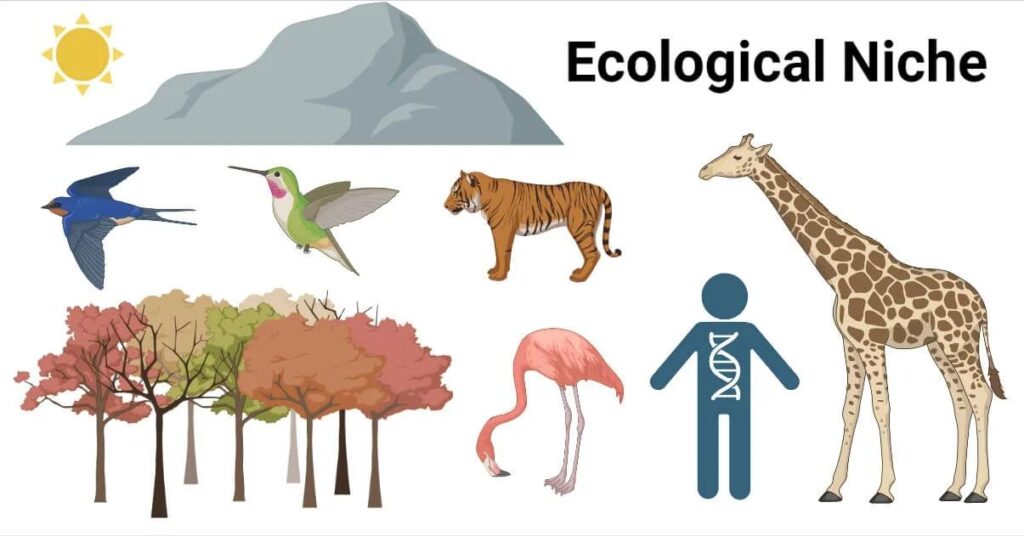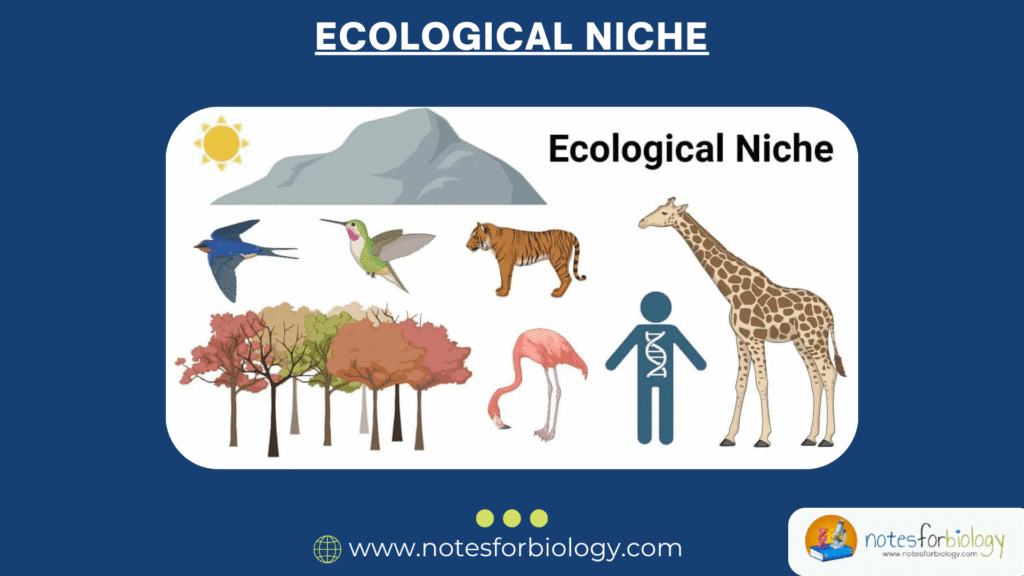Introduction
Nature is full of diverse organisms that share the same environment but behave in different ways. Have you ever wondered why lions and hyenas, though living in the same African savannah, don’t always compete for food? Or why certain plants grow only in specific soil types or sunlight conditions? The answer lies in the concept of an ecological niche.

An ecological niche is one of the most important ideas in ecology because it explains how organisms survive, interact, and coexist. Every organism has a unique way of life, including how it gets food, how it reproduces, where it lives, and how it interacts with others. This specific role or “job” in the ecosystem is what we call its niche.
In this document, we will explore the meaning of an ecological niche, its components, various types, real-world examples, and its importance in nature and conservation. Everything is explained in simple, clear, and humanized language to help you truly understand this essential ecological concept.
Table of Contents
What is an Ecological Niche?
Definition
An ecological niche refers to the role and position a species has in its environment. It includes how an organism uses resources, how it responds to environmental conditions, and how it interacts with other organisms.

Think of a niche as a species’ profession in an ecosystem. Just like people have different jobs in society teacher, doctor, farmer—different species perform different roles in the ecosystem. A niche defines all the environmental conditions that a species needs to survive, grow, and reproduce.
In other words, a niche includes:
- What the organism eats
- Where it lives
- When it is active (day or night)
- How it reproduces
- How it avoids predators
- How it affects and is affected by other organisms
Key Definitions by Ecologists
- Joseph Grinnell (1917): The niche of a species is determined by the habitat in which it lives.
- Charles Elton (1927): Focused on the species’ functional role—what it does in the community.
- G. Evelyn Hutchinson (1957): Defined niche as an “n-dimensional hypervolume” representing all the environmental variables that define where a species can survive.
Each definition adds layers of understanding—from physical location to functional role to complex ecological variables.
Components of an Ecological Niche
An ecological niche is made up of several components that describe how a species survives in its environment. Let’s look at each one in detail.
1. Habitat
- This is the physical space where an organism lives.
- It includes elements like climate, soil, water availability, and shelter.
2. Nutrition and Feeding Behavior
- Describes what the organism eats and how it obtains food.
- For example, a lion is a carnivore that hunts; a cow is a herbivore that grazes.
3. Reproductive Strategy
- Includes mating behavior, season of breeding, and number of offspring.
- Some species reproduce quickly and in large numbers, while others invest more in fewer offspring.
4. Behavioral Adaptations
- Refers to how the species behaves in different environmental situations.
- Nocturnal vs diurnal, migratory vs sedentary, aggressive vs passive.
5. Physiological Adaptations
These are internal features like body temperature regulation, water conservation, or salt tolerance.
6. Role in the Ecosystem
- Describes how the organism affects the environment and other species.
- For example, bees pollinate plants, while vultures clean up carrion.
Types of Ecological Niches
Depending on how a species fits into an ecosystem, niches can be categorized in various ways. The most commonly described types include:

1. Fundamental Niche
This is the full range of environmental conditions and resources a species could potentially use in the absence of competition or predators.
It represents the ideal world for the species.
Example:
- A plant that can grow in full sun and partial shade has a fundamental niche that includes both conditions.
2. Realized Niche
This is the actual set of conditions and resources the species does use due to competition, predation, or other limitations.
It is smaller than the fundamental niche and reflects the real-world scenario.
Example:
The same plant may only grow in partial shade in the wild because larger trees outcompete it in sunny areas.
3. Habitat Niche
Refers specifically to where an organism lives.
Example:
Earthworms live in the soil; tree frogs live on leaves.
4. Trophic Niche
Describes the position of the species in the food chain.
Example:
Herbivores (primary consumers), carnivores (secondary consumers), decomposers.
5. Spatial Niche
Refers to how and where the species uses space.
Example:
Birds that nest in tree canopies versus those that nest on the ground.
6. Temporal Niche
Refers to when a species is active.
Example:
Owls are active at night (nocturnal); sparrows are active during the day (diurnal).
7. Multidimensional Niche
A more complex concept that includes all biotic and abiotic factors—like temperature, humidity, light, and presence of competitors or predators.
This is Hutchinson’s idea of a n-dimensional hypervolume.
Examples of Ecological Niches
Understanding ecological niches becomes clearer with real-life examples. Let’s look at how different organisms occupy unique niches:
Example 1: Honeybee (Apis mellifera)
- Habitat: Gardens, meadows, forests
- Food: Nectar and pollen
- Role: Pollinator
- Activity: Diurnal
- Reproduction: Queen-laying thousands of eggs
- Behavior: Social, lives in hives
Example 2: Bengal Tiger (Panthera tigris tigris)
- Habitat: Forests and grasslands
- Food: Large herbivores like deer and wild boars
- Role: Apex predator
- Activity: Mostly nocturnal
- Reproduction: Solitary breeder
Example 3: Earthworm
- Habitat: Soil, especially moist and rich in organic matter
- Food: Decomposing organic material
- Role: Decomposer and soil aerator
- Activity: Active after rainfall or at night
Example 4: Barnacle Species (on intertidal rocks)
- Some species occupy upper zones (exposed to air more often)
- Others occupy lower zones (immersed in water more often)
- This niche differentiation prevents competition
Example 5: Bats and Swallows
- Both feed on flying insects
- Bats do so at night (nocturnal niche)
- Swallows feed during the day (diurnal niche)
- They avoid direct competition through temporal niche partitioning
Niche Differentiation and Coexistence
In ecosystems where many species live together, niche differentiation allows them to coexist without outcompeting each other.
Species adapt over time to use different resources or to use the same resources in different ways, times, or places. This reduces competition and promotes biodiversity.
Examples:
- Different species of warblers feed on different parts of the same tree.
- Herbivores like giraffes eat leaves from tall trees, while antelopes graze grass.
Niche Overlap and Competition
When two species try to occupy the same niche, competition occurs. If one species is more efficient, it can outcompete and exclude the other—this is called the competitive exclusion principle.
Example:
- Paramecium aurelia and Paramecium caudatum cannot coexist in the same culture with the same food—they compete and one dies off.
Importance of Ecological Niches
Understanding niches is crucial for several reasons:
1. Explains Species Interactions
Niches reveal how species interact with each other (competition, predation, mutualism).
2. Promotes Biodiversity
Niche differentiation allows more species to coexist in the same ecosystem.
3. Aids in Conservation
Knowing the niche of endangered species helps in designing better conservation strategies.
4. Prevents Invasive Species
When invasive species enter a new ecosystem, they may outcompete native species because of niche overlap.
5. Helps Predict Responses to Climate Change
Species with narrow niches (specialists) may suffer, while generalists may adapt more easily.
Generalists vs Specialists
- Generalists: Have broad niches; can survive in a variety of conditions and eat many types of food (e.g., raccoons, cockroaches).
- Specialists: Have narrow niches; adapted to specific environments or diets (e.g., koalas eat only eucalyptus leaves).
Human Impact on Niches
Human activities—like deforestation, pollution, urbanization, and climate change—can destroy or alter the niches of many species. This leads to:
- Habitat loss
- Species extinction
- Spread of invasive species
- Disruption of food webs
Protecting ecological niches is essential for maintaining healthy and balanced ecosystems.
Niche Construction
Some organisms modify their environment in ways that affect their own niche and that of others. This process is called niche construction.
Examples:
- Beavers build dams that create wetlands
- Earthworms enrich soil by burrowing and decomposing organic matter
- Humans build cities and change entire landscapes
Conclusion
The ecological niche is a foundational concept in ecology that describes how an organism lives, survives, and interacts within its environment. It goes far beyond just where a species lives—it encompasses what it eats, how it behaves, how it reproduces, and how it affects and is affected by other organisms and environmental conditions.
Each species has a unique niche that helps maintain the balance of nature. Niche differentiation allows multiple species to coexist in the same habitat, supporting biodiversity. Understanding niches also helps scientists predict how ecosystems respond to changes, protect endangered species, and manage resources wisely.
In today’s changing world, appreciating and respecting the niches of all life forms is not just an academic exercise—it’s essential for the sustainability of our planet.
Three Key Takeaways
- An ecological niche describes the role, behavior, and living conditions of a species in an ecosystem.
- Niche differentiation allows multiple species to live in the same area without direct competition.
- Human activities can disrupt niches, leading to ecological imbalances and species loss.
Frequently Asked Questions (FAQs)
What is the difference between a niche and a habitat?
Habitat is the physical place where an organism lives.
Niche includes the habitat plus the organism’s role, behavior, diet, and interactions.
Can two species have the same niche?
Not for long. According to the competitive exclusion principle, two species with the same niche cannot coexist permanently.
What is a realized niche?
It’s the actual conditions and resources a species uses in nature, considering competition and other limitations.
Related Articles




